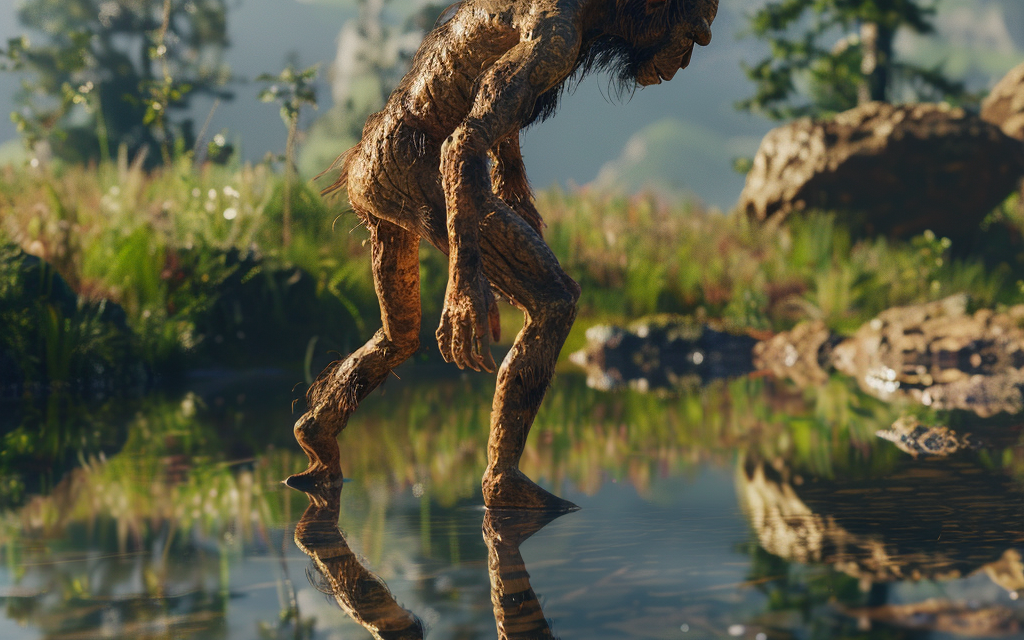Introduction
Walking: It’s not just what we do when we can’t find parking. It’s a hallmark of human evolution, a simple action that sets us apart from our tree-dwelling ancestors. This journey from all fours to two feet is packed with drama, from evolutionary shifts to the sheer willpower of a toddler’s first steps. Let’s stride through the story of bipedalism, where each step isn’t just a move forward but a leap in human development.
The Evolutionary Path to Bipedalism
The journey to bipedalism, a hallmark of human evolution, unfolded over millions of years. Our distant ancestors, the quadrupeds, found themselves in an ever-changing world. As forests receded and open landscapes expanded during the Pliocene era, a new way of moving through the world became advantageous. Walking upright offered a panoramic view in the savanna, allowing early humans to spot both resources and risks in the vast grasslands. This adaptation also meant that hands were freed from the business of locomotion, paving the way for tool use, which in turn, sparked a revolution in how early humans interacted with their environment. This shift was not merely physical but marked the beginning of a profound transformation in our lineage’s way of life, turning early hominins into the first DIY enthusiasts, crafting tools that would gradually reshape their world.
Anatomical Changes for Bipedalism
The transition to upright walking required a series of remarkable anatomical transformations. The human spine, curving into an S-shape, became a model of engineering, balancing the body’s weight over our two feet. This adaptation not only facilitated shock absorption with each step but also supported the upward trajectory of the human form. The pelvis, once configured for a life on all fours, became shorter and wider, providing a stable platform for bipedal locomotion. Meanwhile, our legs elongated, propelling us forward with greater efficiency, and our feet evolved from grasping tools to sturdy supports, complete with arches that act as natural shock absorbers. The culmination of these changes crafted a body uniquely equipped for walking on two legs, a testament to nature’s ingenuity.
Theories on the Origins of Bipedalism
The question of why bipedalism emerged has intrigued scientists for decades, leading to a variety of hypotheses. The savannah theory suggests that as forests gave way to open landscapes, bipedalism offered a survival advantage by enabling early humans to traverse these new terrains more efficiently and spot predators. In contrast, the aquatic ape hypothesis proposes that wading through water-rich environments encouraged our ancestors to adopt an upright stance. Then there’s the endurance running hypothesis, which posits that bipedalism allowed early humans to cover long distances efficiently, an advantage in hunting and scavenging. Each theory underscores the adaptability and versatility of human evolution, reflecting the myriad ways our ancestors interacted with their changing environments.
Learning to Walk: A Developmental Perspective
The first steps of a toddler are a monumental achievement in human development, encapsulating millions of years of evolutionary progress. This milestone is not just a physical feat but a complex interplay of genetics, neurological development, and environmental interaction. From the tentative crawl to the confident stride, each phase of learning to walk is a testament to the inherent plasticity and resilience of the human body. Parents play a pivotal role, offering encouragement and creating safe environments for exploration. This process mirrors the broader journey of human adaptation and learning, showcasing the innate drive to explore and master our surroundings.
Cultural and Societal Impacts of Walking
Walking has been more than a physical activity; it’s a practice imbued with cultural and societal significance. Throughout history, walking has served as a means of exploration, leading humans to discover new lands and connect disparate communities. Pilgrimages and processions have woven walking into the spiritual fabric of societies, transforming simple journeys into profound quests. Moreover, the act of walking together has been a powerful tool for social change, from peaceful protests to marches for rights and recognition. The footprint of walking in human culture is deep, illustrating how this basic mode of movement has carried us through history, not just geographically but socially and spiritually.
Modern Humans and Walking
In the era of digital dominance, walking has transformed from an evolutionary necessity to a conscious choice for many. Our increasingly sedentary lifestyles, coupled with the design of car-centric cities, have relegated walking to the margins of daily life for some, making it an intentional activity rather than an integral part of existence. However, there’s a silver lining as society begins to recognize the multifaceted value of walking—not just for individual health but as a sustainable and community-enhancing practice. Urban areas are gradually embracing the concept of walkability, integrating pedestrian-friendly infrastructure, from sprawling urban trails to green spaces that encourage walking as a pleasure rather than a chore. This shift is also sparking discussions about the impact of modern footwear on our natural gait and the long-term effects of navigating the concrete mazes we call cities. As we navigate this landscape, the re-emergence of walking as a fundamental aspect of healthy, sustainable living underscores a collective desire to return to our ambulatory roots, albeit in a modern context.
Walking Disorders and Rehabilitation
For many, the ability to walk with ease is a given, but for others, it represents a significant challenge, or a milestone to be achieved. Walking disorders, ranging from congenital conditions like cerebral palsy to acquired issues such as those resulting from a stroke, can profoundly impact one’s quality of life. The path to mobility, or regaining it, is fraught with challenges but is also a testament to human resilience and the power of medical and technological advancements. Physical therapy offers personalized approaches to rehabilitation, focusing on strengthening muscles and improving coordination. Meanwhile, the field of prosthetics and orthotics is witnessing revolutionary changes, with devices becoming more adaptable and intuitive, closely mimicking natural movement. Exoskeleton technology, once the realm of science fiction, is now providing tangible hope, assisting those previously deemed immobile to take steps anew. These advancements are not just about restoring function but about reclaiming independence and dignity, proving that barriers to walking can be overcome with innovation and determination.
The Future of Walking: Challenges and Innovations
As we step into the future, the act of walking faces both challenges and opportunities for evolution. The ongoing development of prosthetics and orthotics heralds a new era of mobility, offering hope for enhanced access and independence. Urban planning, too, is at a crossroads, with the potential to reshape cities into pedestrian paradises that promote walking not just as a means of transport but as a pillar of community and wellness. Innovations in smart technology and urban design are poised to make walking safer, more enjoyable, and integral to the fabric of daily life. Moreover, the integration of technology in personal health, such as wearable devices that monitor and encourage movement, suggests a future where walking is seamlessly woven into our digital existence. However, these advancements come with the responsibility to ensure that the benefits of walking—and the innovations that support it—are accessible to all, regardless of physical ability or socioeconomic status. As we navigate the future, the journey of walking continues to mirror the journey of humanity itself—adapting, evolving, and moving forward, one step at a time.
Conclusion
From the first hominins venturing upright to toddlers taking their inaugural steps, walking is a fundamental thread in the human story. It’s a testament to our adaptability, a barometer of our health, and a catalyst for change. As we continue to explore the hows and whys of bipedalism, we’re not just uncovering our past; we’re stepping towards a future where every stride counts.





